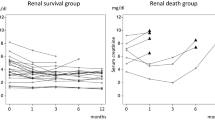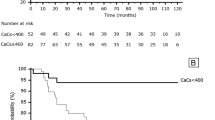Abstract
Background
Cholesterol crystal embolism (CCE) causes renal damage, and there is an extremely high risk of end-stage renal disease. However, the time course of CCE-related renal deterioration varies and little is known about the subsequent risk of dialysis among patients with biopsy-proven CCE.
Methods
We performed a retrospective cohort study of 38 Japanese patients in whom a histological diagnosis of CCE was made from September 1992 to July 2005. Competing risk regression analysis was used to investigate the association between declining renal function ( ≥ 1.5 elevation of serum creatinine within 26 weeks after CCE) or its subtypes (acute [ < 1 week after CCE], subacute [1 to < 6 weeks], and chronic [6 to < 26 weeks]) and the risk of dialysis, with adjustment for age, baseline serum creatinine, and the precipitating event (iatrogenic or spontaneous).
Results
During a median follow-up period of 25.9 weeks, 14 patients (35.9%) started dialysis. Multivariable analysis showed that patients with declining renal function had a higher risk of commencing dialysis than those without declining function (subdistribution hazard ratio [SHR] 9.47; 95% confidence interval [CI] 1.34–66.8). Patients with different renal presentations had a similarly increased risk of commencing dialysis, with the risk being significantly higher for the subacute and chronic patterns of declining renal function (adjusted SHR [95% CI] for acute, subacute, and chronic declining renal function[vs. no decline]: 7.36 [0.85–63.6], 11.9 [1.36–101], and 10.7 [1.49–77.0], respectively).
Conclusion
Declining renal function after CCE, even later than 6 weeks, was significantly associated with the subsequent risk of dialysis.



Similar content being viewed by others
Abbreviations
- CCE:
-
Cholesterol crystal embolism
- SHR:
-
Subdistribution hazard ratio
- CI:
-
Confidence interval
- BP:
-
Blood pressure
- CAG:
-
Coronary angiography
- PCI:
-
Percutaneous coronary intervention
- CABG:
-
Coronary artery bypass grafting
- TACE:
-
Transcatheter arterial chemoembolization
- PTA:
-
Percutaneous transluminal angioplasty
- CKD:
-
Chronic kidney disease
- IQR:
-
Interquartile range
References
Jucgla A, Moreso F, Muniesa C, Moreno A, Vidaller A. Cholesterol embolism: still an unrecognized entity with a high mortality rate. J Am Acad Dermatol. 2006;55(5):786–93.
Donohue KG, Saap L, Falanga V. Cholesterol crystal embolization: an atherosclerotic disease with frequent and varied cutaneous manifestations. JEADV. 2003;17(5):504–11.
Scolari F, Ravani P, Gaggi R, et al. The challenge of diagnosing atheroembolic renal disease: clinical features and prognostic factors. Circulation. 2007;116(3):298–304.
Li X, Bayliss G, Zhuang S. Cholesterol crystal embolism and chronic kidney disease. Int J Mol Sci. 2017;18:6.
Matsuo S, Imai E, Horio M, et al. Revised equations for estimated GFR from serum creatinine in Japan. Am J Kidney Dis. 2009;53(6):982–92.
Kanda Y. Investigation of the freely available easy-to-use software 'EZR' for medical statistics. Bone Marrow Transplant. 2013;48(3):452–8.
Belenfant X, Meyrier A, Jacquot C. Supportive treatment improves survival in multivisceral cholesterol crystal embolism. Am J Kidney Dis. 1999;33(5):840–50.
Fukumoto Y, Tsutsui H, Tsuchihashi M, Masumoto A, Takeshita A. The incidence and risk factors of cholesterol embolization syndrome, a complication of cardiac catheterization: a prospective study. J Am College Cardiol. 2003;42(2):211–6.
Scolari F, Ravani P. Atheroembolic renal disease. Lancet (London, England). 2010;375(9726):1650–60.
Kronzon I, Saric M. Cholesterol embolization syndrome. Circulation. 2010;122(6):631–41.
Ozkok S, Ozkok A. Contrast-induced acute kidney injury: a review of practical points. World J Nephrol. 2017;6(3):86–99.
Lin PH, Bush RL, Conklin BS, et al. Late complication of aortoiliac stent placement- atheroembolization of the lower extremities. J Surg Res. 2002;103(2):153–9.
Acknowledgements
We would like to thank all of the physicians involved in patient care at Toranomon Hospital.
Author information
Authors and Affiliations
Corresponding authors
Ethics declarations
Conflict of interest
The authors declare no competing financial interests. The authors also declare that they have no conflicts of interest.
Ethical standards
The present report adhered to the Declaration of Helsinki.
Additional information
Publisher’s Note
Springer Nature remains neutral with regard to jurisdictional claims in published maps and institutional affiliations.
Electronic supplementary material
Below is the link to the electronic supplementary material.
About this article
Cite this article
Toriu, N., Sumida, K., Mizuno, H. et al. Long-term outcome of biopsy-proven cholesterol crystal embolism. Clin Exp Nephrol 23, 1181–1187 (2019). https://doi.org/10.1007/s10157-019-01749-y
Received:
Accepted:
Published:
Issue Date:
DOI: https://doi.org/10.1007/s10157-019-01749-y




